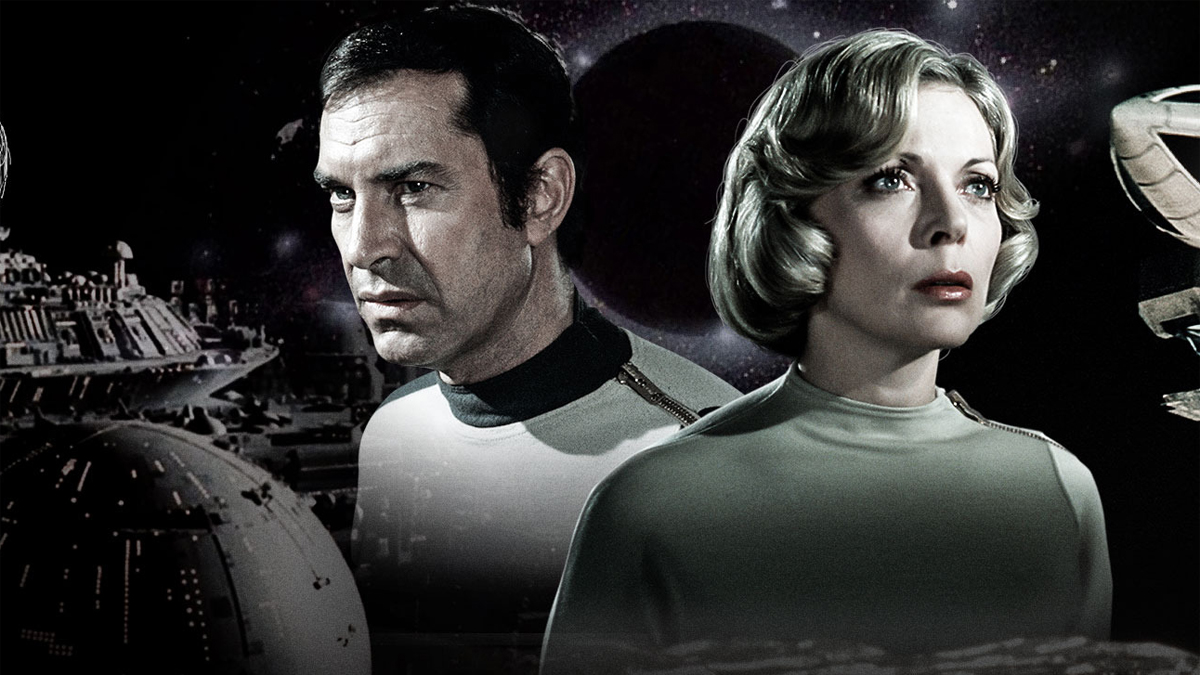
A history of the most underrated British science fiction of the 1970s is, largely, just a history of British science fiction of the 1970s. It gets a bad rap. Think “1970s British Sci-Fi” and your mind will be flooded with associations of dodgy special effects, less-than-perfect gender politics, and so much knitwear. That, and a certain time traveller with a predilection for scarves and jelly babies.
But the truth is the 70s was a golden age for British science fiction stories with ideas and ambition, completely unrestrained by any concept of production values. While even the most pedestrian attempt at modern science fiction telly feels it has to go toe to toe with the MCU’s latest CGI eyeball-blaster, a year after Star Wars was on our screens the Doctor was still routinely facing off against dressed like this, and it was better for it.
Blake’s 7 (1978 – 1981)
Stream on: ITVX (UK); BritBox (UK & US)
Probably the first 70s British sci-fi show you think of that doesn’t feature a TARDIS, although it and Doctor Who have always shared some DNA – the show’s creator was Terry Nation, also the creator of the Daleks. A crossover was suggested multiple times; once when Nation wanted to bring the Daleks in as the Big Bad of season B/series two, and once when Tom Baker and Gareth Thomas, the Blake of Blake’s 7, proposed that they run into each other in a hallway on both shows.
The thing is, while this show fulfils, and even originated every stereotype of ropey British sci-fi you can think of (episode five’s villain looks straight out of The Mighty Boosh), underneath all of that you can see modern television struggling to be born. Firefly, Farscape, Battlestar Galactica – even The Guardians of the Galaxy. None of that exists without Blake’s 7.
Space: 1999 (1975 – 1977)
Stream on: BritBox (UK); Peacock & Fubo (US)
Another series that at first glance ticks all your 70s sci-fi stereotype boxes, with the added hilarity of it now being set a quarter of a century in the past (sorry to everyone who just realised 1999 was a quarter of a century ago).
But to only laugh at the series for being dated is to miss just how weird the show is. The premise alone is breathtaking – an accidental explosion on the Moon hurls it out of Earth’s orbit and into deep space, taking its moon base with it. What catastrophic effect does this have on Earth? How is the planet seemingly going so fast as to encounter a new star system every week but slow enough to stick around for an adventure on each one? That’s not for us to say.
But for the first series at least, Space: 1999 is permeated by a sense of oppressive weirdness even modern TV just can’t compete with. And with superb model work by Gerry Anderson, somehow visually the show still stands up.
Survivors (1975 – 1977)
Stream on: BritBox (UK & US)
Like many of the shows on this list, Survivors hits different today than it did in the 1970s, but for different reasons. The premise – a deadly pandemic that burns across the Earth killing 4,999 people out of every 5,000, hits a little too close to home for modern audiences. It was another series created by Terry Nation, who, like Russell T Davies, tended to veer towards the misanthropic when he wasn’t piloting the TARDIS, although Nation left the show after one series following disputes with producer Terence Dudley.
Like the later Blake’s 7, Survivors is unmistakably British sci-fi. Damp, dingy looking, and populated mostly by absolute bastards.
Quatermass (1979)
Stream on: ITVX (UK), BritBox (UK & US)
The 70s take on a sci-fi franchise legacy sequel. Bernard Quatermass casts a long shadow over British sci-fi TV. He’s considered an influence on Doctor Who (and is referenced several times in the show) but his creator, Nigel Kneale, reportedly loathed it. He had been a star of multiple Hammer horror movies, but started out in a 50s BBC serial that now no longer exists.
Quatermass, a four-part serial designed to be simultaneously released recut as a movie in the States, is the fourth TV outing of the former head of the British Experimental Rocket Group, after The Quatermass Experiment, Quatermass II and Quatermass and the Pit. The plot features standing stones, a youth cult, and an alien harvest, and ends with the hero nuking himself and triggering the downfall of technological civilisation.
It got a mixed reception at the time, but this is very much a modern Quatermass story dealing with contemporary concerns, not an exercise in nostalgia.
U.F.O. (1970 – 1971)
Stream on: ITVX, BritBox (UK); Filmrise (US)
This was Gerry Anderson’s first foray into live-action TV, though feels a lot more akin to his work on Thunderbirds and Stingray. It’s still a good deal more expensive looking than the likes of Blake’s 7, with all the trappings of retro sci-fi – moon bases, silver jumpsuits, women with identical purple haircuts and people smoking in pressurised habitats.
Set in the future 1980s, the show features the heroic SHADO agency fighting clandestine incursions by organ-harvesting aliens who may be laying the groundwork for a full-on invasion. It’s not as weird, subversive or unnerving as others on this list, but out of all of them, it may have the best polish.
Doomwatch (1970 – 1972)
Stream on: Prime Video (rent/purchase only); Flixfling (US)
Would it surprise you to know that the creator of one of Doctor Who’s most enduring monsters would later strike out on their own to create a new science fiction series with a far darker perspective on humanity? Okay, but this time it’s not Terry Nation.
Gerry Davis and Kit Pedler, the creators of the Cybermen, here tell the story of the “Department for the Observation and Measurement of Scientific Work”, an official agency dedicated to policing unprincipled scientific research. Tragically, 14 episodes of this show have been lost; this being a period when the BBC still chucked priceless television history into one of those Christmas tree-shredding machines for a laugh.
The show was aiming for a Black Mirror-esque, “ripped from the headlines” feel, with stories about a virus that eats plastic, genetic engineering, environmental threats, subliminal advertising, and most famously, hyper-intelligent carnivorous rats.
1990 (1977 – 1978)
Not officially streaming
It is 1990, and the future. You can tell because people are wearing collarless shirts without ties. Starring The Wicker Man’s Edward Woodward, 1990 features a dystopian Britain where the House of Lords has been abolished, all the businesses are state-owned, the armed forces have been dramatically cut back and the nation is gripped in an iron fist by a cabal of civil servants and trade unionists. You know – the future that liberals want.
Largely forgotten aside from a DVD release in 2017, this show is nevertheless that rare thing, a vision of a dystopian Left-Wing future that explores the question “Yeah but is it actually worse than Thatcherism though?”
The Guardians (1971)
Not officially streaming
Long before 1990 gave us a vision of a dystopian socialist Britain, however, The Guardians showed us Britain under good old-fashioned fascism. The story was told from both within the fascist government and the resistance movement “Quarmby” (Britain is not good at naming resistance movements). While moderate factions were seen jostling for control on both sides of the conflict, the show was banned from being broadcast in Northern Ireland, since ‘characters committing heroic acts of terrorism against the British government’ wasn’t the kind of message they wanted to spread.
The Omega Factor (1979)
Not officially streaming
One thing this list has really been missing so far is a great big heap of psychic woo. It’s hard to believe now, but there was a time when belief in ESP, telekinesis, hypnosis and psychic powers was considered not only mainstream, but an area for serious scientific investigation. It seems weird now, watching the original Star Trek, that ESP screening is considered routine in Starfleet, but to contemporary audiences, it would have seemed far more scientific than a transporter beam.
And so we come to The Omega Factor, a series following the secretive Department 7 in their investigation of paranormal phenomena and the potential of the human mind, combating “Omega”, a dark conspiracy run by a rogue psychic.
It’s full of 70s cheesiness, but the chemistry between stars James Hazeldine and Louise Jameson (Doctor Who’s Leela!) makes a pretty good blueprint for Mulder and Scully 20 years later.
Moonbase 3 (1973)
Not officially streaming
Would it also surprise you to know that the creator of one of Doctor Who’s most enduring monsters (okay, the robot in “Robot”) would later strike out on their own to create a new science fiction series with a far darker perspective on humanity? Yes, okay, maybe the Robot K1 isn’t exactly an “enduring” one, but Terrance Dicks is certainly one of Who’s more memorable writers.
And Moonbase 3 is certainly a darker perspective on humanity, created in collaboration with former Doctor Who producer, Barry Letts.
Set in 2003, the series depicts the European Moonbase 3, the budget equivalent of the better-funded American Moonbase 1 and Russian Moonbase 2. The show could get pretty grim, with its focus on technical failures, bureaucratic struggles and the mental and emotional strain of living in space, but in its attempts to portray a more realistic version of space travel it paved the way for many shows that came later.
Sapphire & Steel (1979 – 1982)
Stream on: ITVX, BritBox (UK); Fubo (US)
In an age where every TV show has its own wiki, and to be a fan is less about enjoying a show than considering yourself a kind of monastic chronicler of “The Lore”, Sapphire and Steel is even harder to comprehend today than when it was aired.
Sapphire and Steel are elements, played by Joanna Lumley (Absolutely Fabulous) and David McCallum (Ducky in NCIS). Does that mean they’re named after elements or that they’re somehow the anthropomorphic personification of those elements? Does it matter that neither Sapphire nor Steel are actually elements?
It doesn’t matter, what matters is they’re investigating irregularities in the flow of Time, which appears to be a sentient force and also evil. Old things have lots of time, and so are dangerous. No, we will not elaborate.
But despite, or maybe because of, the show’s admirable refusal to explain anything, Sapphire & Steel told some truly unnerving stories, constantly dancing the line between science fiction and ghost story. If anyone tried to make it today they would doubtless explain everything, or at least tease the answers as some JJ Abrams-style Mystery Box, and that would ruin it.
The post The Best 1970s British Sci-Fi TV Series (That Aren’t Doctor Who) appeared first on Den of Geek.







